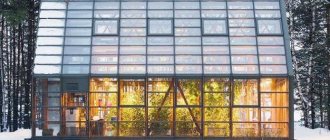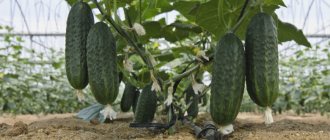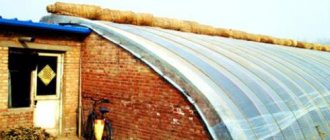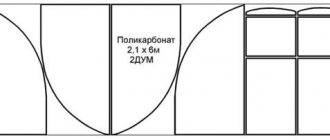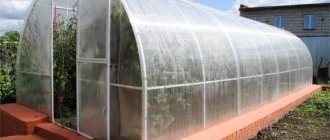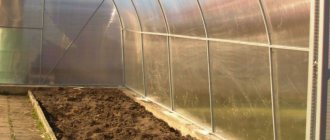Only greenhouses with a total area of more than 10 m2 are installed on the foundation. The rest of the structures can get by with temporary foundations or without them at all, because polycarbonate is strong and holds its shape well, but at the same time it is flexible and will withstand small movements of the earth without harming itself.
Fifth generation greenhouses Ultra Clima (Ultra Clima)
Once upon a time I thought about it and even asked on this forum whether to run cold well water through the heating system in the summer to cool greenhouses. Do you remember? I was then told that there would be dampness in the greenhouses and drops. In the summer, extra moisture in the heat of the day would not hurt, especially since there is no place to drip onto the plants other than the external contour. Our water is +16 - +18. All year round. THIS is good because it heats “a little”, but for cooling purposes it was not so interesting.
But then, having discussed this “fixed idea” with designers and contractors - thermal engineers, we came to a disappointing conclusion:
The water in the heating system circulates “prepared” - i.e. a complexone is added to it, it is partially regulated in terms of overall rigidity. In addition, over time, the amount of oxygen in this water decreases to almost zero and it becomes neutral to the metal of the heating system pipes.
When pumping well water directly into the heating system of the greenhouse (cutting off the boilers, of course) with main pumps and distributing it along the circuits, we literally kill the heating system.
Undoubtedly, it is possible to organize the circulation of well water through a heat exchanger and the transfer of a negative gradient in the temperature of the “heat-coolant” to the heating system. In this case, the problem goes away, but additional problems appear. circuits, capacity limitations on the heat exchanger, etc.
Well, the most important problem in this undertaking is that if the goal is to cool the greenhouse for a better climate, the heated water needs to go somewhere...
In the case of heat accumulation in an accumulator tank during heating, this is all useful. Based on the capacitor principle. But what about preserving the “solar” heat in slightly heated water, which is many times larger in volume? Warm up the lake?
This is where the diagram of a heat pump (refrigerator) suggests itself.
Wherever there is a difference in temperature you can benefit.
And the higher the temperature difference, the higher this benefit.
But nothing is said about this. One could figure out how to “enrich” thermal energy, i.e. make it more concentrated - from 35 degrees. do, for example, 85-90 degrees, but in a much smaller volume. Moreover, using the same existing battery tank.
Well water, when used to cool greenhouses, was clean and remained so - it can be driven into the same layers. This is logical. But according to the law in the Russian Federation, this can never be done under any circumstances, because These are drinking horizons. With technical horizons, it’s possible. But there is salt there... So it will be necessary to pump it into the higher layers.
Moreover, this is a “one-way ticket”; picking her up when it’s warm at night, or especially in winter, is not possible.
It will take on the temperature of the surrounding rocks at the depth of the absorption layer in a matter of minutes.
There is no “huge bath” underground in which you can heat millions of cubic meters of water for the whole winter for yourself and for the neighboring country using solar energy. In winter you will rise to “different” water, just as you enter a river into “different” water each time. And its temperature will be the same as always at this depth.
If we remember about underground gas storage facilities, where billions of m3 of gas are pumped for storage, then this is somewhat different. Rock structures of porous rock (sandstone or limestone) are locally limited by impermeable rocks. The result is a kind of porous structure (a washcloth in a case), closed in an impenetrable “armor”. So gas is pumped into it, displacing the agent that was present in the pores before - water, condensate, a mixture of condensate with oil, etc.
Of course, there are karst caves in nature, huge “halls” of millions of m3, where the water can be +4 degrees, and somewhere +45. But these are isolated cases. Moreover, interference in the thermodynamic balance of such natural anomalies is fraught with tectonic disturbances. Imagine you start storing warm water in a cave where it was +4 for millions of years.
Not only will you experience tremendous heat loss until the thermodynamic balance of heat inflow/outflow is aligned with its outflow into the cold walls of the cave, but problems may also arise with the “supporting structure” itself.
One gets the impression that the Dutch are putting a lot of pressure on their ears, taking advantage of the fact that most people from the greenhouse industry have little understanding of geology, well construction, or thermodynamic processes.
NPF "FITO"
Sokolov Igor Sergeevich, director of NPF "FITO", for the magazine "Agribusiness"
Agricultural production in the modern world is undoubtedly an attractive area for investment. The increasingly frequent global economic crises significantly increase the risk of investment in the production of industrial goods, and, on the contrary: the production of agricultural products practically does not suffer from the situation in the world, since food supplies the daily needs of humans. One of the most attractive areas for investing money is building a greenhouse business for intensive production of vegetable products. Modern greenhouse complexes provide, perhaps, the most profitable production in the field of agriculture, since they are based on the principles of intensive vegetable production with deep automation of growing processes. However, entering this business requires significant capital investments. The estimated cost of a modern greenhouse complex “from scratch” and “turnkey” is approximately 1.8 billion rubles for a 10-hectare project. Such capital investments must work effectively and ensure a payback period for the project within 6 years. This is only possible if we use the latest advances in this area.
Russian, a manufacturer of automated technological equipment systems, together with Dutch partners, leading manufacturers of greenhouse structures KUBO, present the fifth generation greenhouse technologies innovative greenhouses ULTRA CLIMA. Greenhouses of this class were born about eight years ago and today they are being intensively constructed all over the world. This is truly a revolution in the world of greenhouses. What is their main difference from fourth generation greenhouses?
Modern fourth-generation greenhouses of the VENLO type are greenhouses up to 8 meters high, well sealed, with a high degree of automation, allowing the implementation of advanced technologies for growing vegetables. With the introduction of these greenhouses, it was possible to significantly increase the yield of vegetable products, and light culture technologies completely doubled the yield of vegetables per square meter. However, these highly profitable greenhouses also have significant drawbacks that do not allow them to fully obtain the harvest that is biologically inherent in the hybrids. The most significant of the shortcomings is the inability of the greenhouse to maintain an optimal microclimate at certain times of the year. This drawback begins to manifest itself in the spring, and even earlier when using light culture technology. At this time, overheating begins to appear in the greenhouse and, in order to maintain a given microclimate, it is necessary to open the windows, which entails excessive consumption of thermal energy, and also, which is very significant, the plants receive a temperature shock due to the cold air descending and this negatively affects the plants and leads to loss of yield. The result is a negative multiplier effect: it is impossible not to open the windows because the plants are “steamed,” and when opened, the top of the plant is damaged and heating costs increase. During the summer period of growing vegetables, a fourth-generation greenhouse is, in principle, unable to maintain the required microclimate, since there are no resources to reduce the temperature.
The fifth generation greenhouse, the so-called “semi-closed greenhouse”, created using Ultra Clima technology, retains all the advantages of VENLO-type greenhouses, but in many ways surpasses it in a number of parameters:
- The greenhouse maintains an ideal microclimate at any time of the year.
- In winter or spring, when there is overheating, just like in simple greenhouses, the vents are opened slightly, although these vents are 90% smaller than in conventional greenhouses and they only serve to relieve the slight excess pressure under which the Ultra Clima greenhouse is located. In this case, the air always leaves the greenhouse and a temperature shock is fundamentally impossible here, and since there are a small number of vents, there is correspondingly less heat loss.
- In the summer, the greenhouse is able to cool itself. It is equipped along its entire length with adiabatic panels onto which water flows. As the water evaporates, it takes away some of the energy and the air, thus cooled, enters the greenhouse. Practical use of such a cooling system in a greenhouse in Dankov, Lipetsk region. showed that it is possible to reduce the temperature in the greenhouse to 10 °C, which, in turn, has a beneficial effect on the plants and there is no loss of yield.
- A greenhouse allows you to save heating costs.
This happens due to the recycling of thermal energy. In a conventional greenhouse, warm air from the heating pipes rises and goes outside through the glazing of the greenhouse roof, and the greater the temperature difference between the outside and inside air, the higher the intensity of transpiration. Naturally, in winter, heat consumption is maximum. In Ultra Clima greenhouses, warm air rising upward is selected by fans and again supplied for heating through plastic hoses located under each bed. This effect is especially enhanced when using light culture technology. The heat from the lamps, which is approximately 90% of the lamp power, evaporates irrevocably in a simple greenhouse, but in the Ultra Clima greenhouse it is almost completely used for heating.
- The greenhouse can maintain an optimal level of CO2 at any time.
It is known that during the period when the windows have to be opened, it is not possible to maintain the CO2 level required for the technology in a simple greenhouse. He always strives for the natural background on the street, which is approximately 400 ppm. This level of CO2 is insufficient for complete photosynthesis, which leads to crop loss. In the Ultra Clima greenhouse, due to its “semi-closed” nature, it is possible to maintain the required CO2 concentration to a much greater extent, and this has a beneficial effect on productivity.
- The greenhouse is protected from pests.
One of the features of the Ultra Clima greenhouse is the presence of excess pressure inside. When the windows and entrance gates are opened, insects cannot overcome the force of excess pressure and do not enter the greenhouse.
- There is no air stagnation in the Ultra Clima greenhouse, which prevents the development of diseases, thanks to film sleeves located under each bed.
In addition to these obvious advantages, there are a lot of accompanying ones that synergistically enhance the efficiency of the greenhouse.
- For example, in the spring-summer period, when the temperature in a simple greenhouse reaches 35 ° C with high humidity, the work of greenhouses becomes, to put it mildly, uncomfortable, and this is a significant loss of labor productivity, not to mention staff turnover due to difficult working conditions. In the Ultra Clima greenhouse, temperatures almost never exceed 24°C, which allows workers to comfortably perform their duties.
- Air hoses under each bed, which serve to supply warm air with specified parameters, provide the so-called “active microclimate”. In a simple greenhouse, this requires heating the registers, which also leads to excessive consumption of thermal energy.
- Etc.
The above advantages really do exist, as they are confirmed by the practice of operating such greenhouses in Russia. Our company Fito, in collaboration with the Greenhouse Technologies company, built the first greenhouse of this class in Dankov, Lipetsk region.
Fifth generation greenhouse using Ultra Clima technology.
Greenhouse structures from the KUBO company, which has priority for this concept, computer control of all systems from the FITO company
Already the first trial operation of these greenhouses by a team of greenhouse growers and agronomists who had no prior experience in working in greenhouses, and even under conditions of late planting (February 6), made it possible to obtain good results in tomatoes in the first year:
Yield of Torero and Starbuck tomatoes in 2014 (kg/m2)
| April | May | June | July | August | September | October | November | December | Total |
| 0,38 | 10,38 | 10,93 | 10,26 | 8,2 | 6.67 | 5,16 | 4,41 | 0,68 | 57,07 |
In addition, we already see a lot of opportunities that this greenhouse provides for increasing the yield.
For example, maintaining the microclimate in a simple greenhouse, all other things being equal, is possible only due to the water temperature and opening the windows, but for comparison, in the Ultra Clima greenhouse, climate maintenance occurs due to at least six parameters and combinations between them, which generally provide unlimited possibilities, possibly not yet fully explored.
As for the capital investments for such a greenhouse, they are on average 20% higher than the traditional one, but various financial models that we have built and confirmed in practice allow us to say that the payback period for such greenhouses is shorter, and they have competitive advantages expressed in lower costs and product quality is significantly higher.
Ultra Clima technologies for the first time in Russia. Article in the Kommersant-Chernozemye newspaper
08.08.2013
"Kommersant-Chernozemye" published the article " Greenhouse technologies have entered the business " using the results of marketing research on greenhouse vegetable growing conducted by.
a greenhouse complex worth 3.5 billion rubles began Its first stage will be launched at the end of this year, and the enterprise will reach its full design capacity - about 20 thousand tons of vegetables per year - in 2016. The capital's NPF FITO and Greenhouse Technologies LLCs, which participated in almost all major greenhouse projects in Russia as consultants and technology suppliers, acted as investors for the first time.
The greenhouse complex is being built in three stages: the first, 9.5 hectares, will be partially launched this year (4.3 hectares), in September 2014 - another 5 hectares (construction began in June), the second and third stages - 11 .5 hectares - by 2016. According to investors’ plans, the harvest from the first stage alone is expected to be about 8 thousand tons per year, and the enterprise will reach its full design capacity of about 20 thousand tons of vegetable products (cucumbers, tomatoes, eggplants and peppers) per year in 2016.
The project is the first attempt by NPF FITO LLC and Greenhouse Technologies LLC to act as investors. Companies operating in this market since 1991 have participated in almost all major core projects in Russia as consultants and technology suppliers, promoting innovations, including Ultra Clima technologies from the Dutch company KUBO. According to the administration of the Dankovsky district, this technology can reduce greenhouse energy costs by 15% and increase yields by 25% compared to other modern complexes. In this project, the yield is expected to be up to 120 kg of cucumbers per 1 sq. m (versus the usual 100 kg) and up to 70 kg of tomatoes per 1 sq. m (55 kg). The project is being implemented by Lipetskagro Greenhouse Plant LLC with the involvement of borrowed funds.
Tamara Reshetnikova, Research Company Growth Technologies LLC believes that if Ultra Clima technologies can really reduce energy costs by 15%, this is a big plus for the project. Indeed, in the cost structure, even in modern greenhouse complexes, which are noticeably ahead of the old Soviet ones in this sense, energy costs are at least 30%. In general, the expert assessed the approach of investors positively: “Many have money and desire, but without experience in such a knowledge-intensive industry, you can encounter unforeseen complications. And NPF “FITO” monitors innovations in this area and tries to implement them in Russia, participating in one form or another in various regional projects, and, as far as I know, this approach justifies itself.”
Let us add that in the last two years, market participants have noted a revival in the field of greenhouse vegetable growing : ambitious statements about the start of new projects come from almost all regions of the Black Earth Region.
Author Olga Zapunaya
The full text of the article can be found in the Kommersant , issue No. 140, 08/08/2013.

